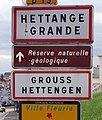| Revision as of 11:24, 5 September 2016 editGreenC bot (talk | contribs)Bots2,547,818 editsm WaybackMedic 2← Previous edit |
Revision as of 12:28, 12 September 2016 edit undoThePierrasse (talk | contribs)456 edits added InfoboxNext edit → |
| Line 1: |
Line 1: |
|
{{Distinguish|Lorrain dialect|Alsatian dialect}} |
|
{{Distinguish|Lorrain dialect|Alsatian dialect}} |
|
|
{{Infobox language |
| ⚫ |
] |
|
|
|
|name = Lorraine Franconian |
|
|
|nativename = Lottrìnger Plàtt |
|
|
|states = ] |
|
|
|region = ] |
|
|
|speakers = c. 360,000 |
|
|
|date = 1962 |
|
|
|ref = |
|
|
|familycolor = Indo-European |
|
|
|fam2 = ] |
|
|
|fam3 = ] |
|
|
|fam4 = ] |
|
|
|fam5 = ] |
|
|
|fam6 = ] |
|
|
|minority = {{FRA|France}} |
|
|
|agency = ''No official regulation'' |
|
|
|iso3 = |
|
|
|iso3comment = |
|
|
|glotto = |
|
|
|glottoname = |
|
|
|map = Dialectes de Moselle.svg |
|
⚫ |
|mapcaption = Dialects of Moselle. Those in purple areas are lumped under the term "Lorraine Franconian" when spoken in France. |
|
|
}} |
|
{{Lorraine sidebar}} |
|
{{Lorraine sidebar}} |
|
⚫ |
'''Lorraine Franconian''' (Lorraine Franconian: ''Plàtt'', ''lottrìnger Plàtt''; {{lang-fr|francique lorrain, platt lorrain}}; {{lang-de|Lothringisch}}) is an ambiguous designation for ]s of ] ({{lang-de|Westmitteldeutsch}}), a group of ] dialects spoken in the ] department of the former north-eastern ] region of ] (See ]). |
|
|
|
| ⚫ |
'''Lorraine Franconian''' (Lorraine Franconian: ''Plàtt'', ''lottrìnger Plàtt''; {{lang-fr|francique lorrain, platt lorrain}}; {{lang-de|Lothringisch}}) is an ambiguous designation for ]s of ] ({{lang-de|Westmitteldeutsch}}), a group of ] dialects spoken in the ] département in the north-eastern ] region of ] (See ]). |
|
|
|
|
|
|
== Description == |
|
== Description == |
|
⚫ |
] |
|
The term ''Lorraine Franconian'' has multiple denotations. Some scholars use it to refer to the entire group of West Central German dialects spoken in the French Lorraine region. Others use it more narrowly to refer to the ] dialect spoken in the valley of the river ] (in Pays de Nied whose largest town is ]), to distinguish it from the other two ] dialects spoken in Lorraine, ] to the west and ] to the east. |
|
The term ''Lorraine Franconian'' has multiple denotations. Some scholars use it to refer to the entire group of West Central German dialects spoken in the French Lorraine region. Others use it more narrowly to refer to the ] dialect spoken in the valley of the river ] (in Pays de Nied whose largest town is ]), to distinguish it from the other two ] dialects spoken in Lorraine, ] to the west and ] to the east. |
|
|
|
|
| Line 12: |
Line 34: |
|
|
|
|
|
The most reliable data comes from the ''Enquête famille'' carried out by ] (360,000 in the 1962 census) as part of the 1999 ], but they give a somewhat indirect picture of the current situation (see ] for a discussion of this survey). Approximately 78,000 people were reported to speak Lorraine Franconian, but fewer than 50,000 passed basic knowledge of the language on to their children. Another statistic illustrating the same point is that of all adult men who used Franconian regularly when they were 5, less than 30% use (or used) the language regularly with their own children.<ref>Héran</ref> |
|
The most reliable data comes from the ''Enquête famille'' carried out by ] (360,000 in the 1962 census) as part of the 1999 ], but they give a somewhat indirect picture of the current situation (see ] for a discussion of this survey). Approximately 78,000 people were reported to speak Lorraine Franconian, but fewer than 50,000 passed basic knowledge of the language on to their children. Another statistic illustrating the same point is that of all adult men who used Franconian regularly when they were 5, less than 30% use (or used) the language regularly with their own children.<ref>Héran</ref> |
|
|
|
| ⚫ |
] |
|
|
] |
|
|
|
|
|
|
== Bilingual signs == |
|
== Bilingual signs == |
| Line 40: |
Line 59: |
|
{{Lorraine topics}} |
|
{{Lorraine topics}} |
|
|
|
|
|
] |
|
] |
|
] |
|
] |
|
] |
|
] |
 Dialects of Moselle. Those in purple areas are lumped under the term "Lorraine Franconian" when spoken in France.
Dialects of Moselle. Those in purple areas are lumped under the term "Lorraine Franconian" when spoken in France. Flag of Lorraine since the 13th century
Flag of Lorraine since the 13th century


